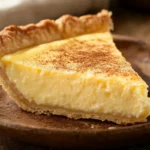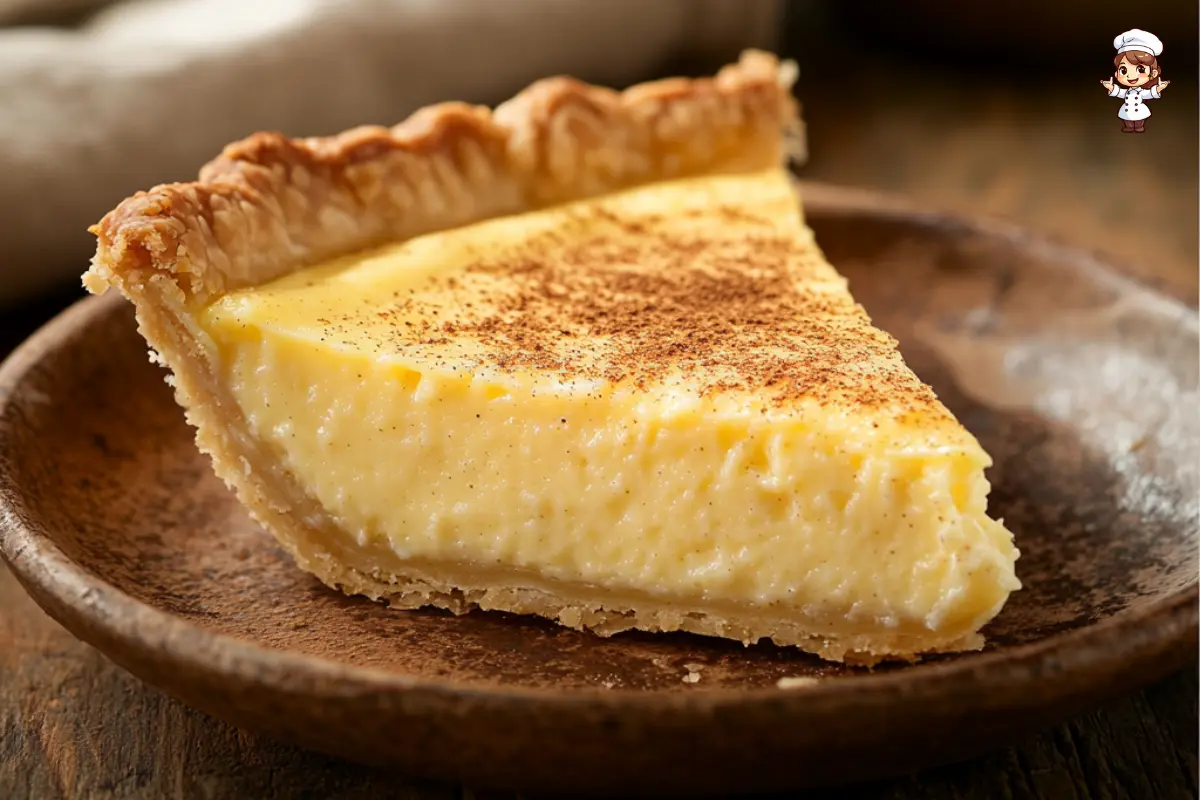Egg custard pie is the epitome of comfort food—smooth, creamy, and wrapped in a buttery crust. This classic egg custard pie recipe has been a family favorite for generations, offering a balance of rich custard filling and flaky crust. Whether you enjoy it warm or chilled, it’s a timeless dessert that never fails to impress.
In this guide, we’ll explore everything you need to know about crafting the perfect egg custard pie recipe. From essential ingredients and step-by-step instructions to tips for avoiding common pitfalls, this article is your go-to resource. Plus, we’ll dive into creative variations, serving ideas, and even some helpful nutritional insights. Let’s get started!
The History and Timeless Appeal of Egg Custard Pie
Egg custard pie has been a staple in kitchens for centuries, tracing its roots back to European cuisine. This dessert was adored for its simplicity—using basic pantry ingredients like eggs, milk, and sugar to create something decadent yet humble. Over time, it became a favorite in households around the world, often making appearances at holiday dinners and family gatherings.
What sets this pie apart is its versatility. It’s just as welcome at a casual Sunday brunch as it is at a festive celebration. Its silky texture and mild sweetness allow it to pair beautifully with a variety of meals, making it a dessert that transcends occasions.
What Makes Egg Custard Pie Unique?
The charm of an egg custard pie recipe lies in its balance. The creamy custard filling is rich yet light, thanks to the eggs and milk, while the crust provides the perfect contrast with its crisp, flaky texture. A hint of nutmeg or vanilla adds warmth and depth to every bite, making this pie a timeless favorite.
Whether you’re a seasoned baker or trying this recipe for the first time, there’s something incredibly rewarding about creating a pie that’s both simple and elegant. Ready to gather your ingredients?
Print
Egg Custard Pie Recipe
- Total Time: 3 hours 10 minutes
- Yield: 8 servings
Description
Enjoy this classic egg custard pie recipe, a timeless dessert that’s perfect for any occasion! 🍮
Ingredients
For the Crust:
– 1 ½ cups all-purpose flour
– ½ teaspoon salt
– ½ cup unsalted butter, cold and cubed
– 3-4 tablespoons ice water
For the Filling:
– 3 large eggs
– 2 cups whole milk (or half-and-half for a richer texture)
– 1 cup granulated sugar
– 1 teaspoon vanilla extract
– ½ teaspoon ground nutmeg (plus extra for garnish)
– Pinch of salt
Instructions
1. Prepare the Crust:
1. In a large bowl, mix flour and salt. Cut in the cold butter using a pastry cutter or your fingers until the mixture resembles coarse crumbs.
2. Gradually add ice water, one tablespoon at a time, mixing until the dough comes together. Form into a disk, wrap in plastic wrap, and refrigerate for 30 minutes.
3. Roll out the dough on a floured surface to fit a 9-inch pie pan. Press it into the pan, trim the edges, and crimp as desired. Chill the crust while preparing the filling.
2. Blind Bake the Crust:
1. Preheat your oven to 375°F (190°C).
2. Line the crust with parchment paper or foil and fill it with pie weights or dried beans.
3. Bake for 12-15 minutes. Remove weights and bake for another 5 minutes until lightly golden. Let cool.
3. Prepare the Custard Filling:
1. In a medium bowl, whisk the eggs until smooth.
2. Add sugar, milk, vanilla extract, nutmeg, and a pinch of salt. Mix until well combined.
3. Strain the mixture through a fine mesh sieve for a silky custard.
4. Assemble and Bake:
1. Reduce oven temperature to 325°F (165°C).
2. Pour the custard filling into the pre-baked crust.
3. Bake for 45-50 minutes or until the custard is set but slightly jiggles in the center.
5. Cool and Serve:
1. Allow the pie to cool at room temperature, then refrigerate for at least 2 hours before serving.
2. Garnish with a sprinkle of nutmeg or a dollop of whipped cream, if desired.
Latest Amazon Finds
Notes
Storage:
– Refrigerator: Store in an airtight container for up to 4 days.
– Freezer: Wrap tightly and freeze for up to 2 months. Thaw in the fridge overnight before serving.
- Prep Time: 20 minutes
- Cook Time: 50 minutes
Essential Ingredients for Egg Custard Pie
Key Ingredients for the Filling
The heart of any egg custard pie recipe is the silky filling, which relies on a few simple yet essential ingredients. Eggs are, of course, the main star. They give the custard its rich texture and help it set during baking. Milk is another key component, providing the creamy base that makes this dessert so irresistible. Whole milk is ideal, but you can substitute with half-and-half or heavy cream for an even richer pie.
Sugar sweetens the custard, while a pinch of salt balances the flavors. To enhance the taste, vanilla extract adds a touch of warmth, and freshly grated nutmeg gives the pie its signature aroma. Together, these ingredients create a harmonious blend of flavors that define a classic egg custard pie.
Choosing the Right Crust
The crust is just as important as the filling in any egg custard pie recipe. A homemade pastry crust is a traditional choice, offering a buttery, flaky base that complements the smooth custard. If you’re short on time, a store-bought crust works just as well.
For a unique twist, consider using a graham cracker crust, which adds a hint of sweetness and crunch. Regardless of your choice, blind baking the crust ensures it stays firm and doesn’t become soggy when the custard is added.
Now that we’ve covered the ingredients, it’s time to move on to preparing the crust.
Preparing the Crust
How to Blind Bake
Blind baking is a must for an egg custard pie recipe to prevent the crust from becoming soggy. Start by preheating your oven to 375°F (190°C). Roll out your pie dough and fit it into a 9-inch pie pan. Trim the edges and crimp them for a decorative finish.
Line the crust with parchment paper or aluminum foil, then fill it with pie weights or dried beans to keep it from puffing up. Bake the crust for about 10-12 minutes, or until the edges are lightly golden. Remove the weights and parchment paper, then bake for another 5 minutes to firm up the base. Let the crust cool slightly before adding the custard filling.
Alternative Crust Options
While a classic pastry crust is a staple, there are alternative options to suit your taste or dietary needs. A graham cracker crust adds a sweet, crumbly texture that pairs wonderfully with custard. For a gluten-free option, try a crust made with almond flour and butter—it’s both delicious and easy to prepare.
Whether you stick to tradition or try something new, the crust sets the stage for your custard pie’s success. In the next part, we’ll dive into crafting the creamy filling that brings it all together!
Crafting the Custard Filling
Mixing Ingredients for a Smooth Custard
The filling is the heart of any egg custard pie recipe, and getting it just right is essential. Begin by cracking three large eggs into a mixing bowl. Whisk them until the yolks and whites are well combined but not frothy—over-mixing can create air bubbles, which affect the texture. Gradually add 1 cup of sugar, whisking constantly to dissolve it completely.
Next, pour in 2 cups of whole milk or half-and-half, depending on how creamy you want your pie. Stir gently to incorporate. Add 1 teaspoon of vanilla extract for a hint of warmth and ½ teaspoon of freshly grated nutmeg for a classic touch. A pinch of salt helps balance the sweetness and enhances the custard’s flavor.
Techniques for Perfect Texture
For a velvety custard, strain the mixture through a fine mesh sieve to remove any lumps or impurities. This step ensures a smooth, creamy texture every time. When pouring the custard into your pre-baked crust, do so carefully to avoid disturbing the crust.
Bake the pie at 325°F (165°C) for 45-50 minutes, or until the custard is set but still slightly jiggly in the center. Overbaking can cause the custard to crack, so keep an eye on it during the final minutes. Let the pie cool completely before slicing—it’s worth the wait!
For more baking inspiration, check out this almond nut cake recipe for another comforting dessert idea.
Baking Tips for Egg Custard Pie
Temperature and Timing
The secret to a perfect egg custard pie recipe lies in baking it low and slow. This method ensures the custard sets evenly without overcooking. Preheat your oven to 325°F (165°C) and place the pie on the middle rack to avoid uneven heat.
To test for doneness, insert a knife or toothpick near the center—it should come out clean but still moist. If the edges look set while the center has a slight jiggle, your pie is ready. Remember, the custard will continue to firm up as it cools.
Troubleshooting Common Issues
Custard pies can be finicky, but with a few tips, you can avoid common pitfalls. If your pie cracks, it’s likely due to overbaking. Using a water bath can help regulate the temperature and create a gentler cooking environment. Simply place the pie pan in a larger pan and add hot water until it reaches halfway up the sides of the pie pan.
To prevent the crust from burning, cover the edges with aluminum foil or a pie shield during baking. This trick ensures the crust stays golden and flaky without over-browning.
With these tips in hand, you’re ready to bake a custard pie that’s as delicious as it is beautiful. Stay tuned for creative variations and serving suggestions in the next sections!
Creative Variations of Egg Custard Pie
Flavor Infusions
If you’re looking to elevate your egg custard pie recipe, adding a new flavor twist is an easy way to make it stand out. Lemon is a popular choice—simply add 1-2 tablespoons of freshly squeezed lemon juice and a teaspoon of lemon zest to the custard mixture. This brightens the dessert and gives it a refreshing citrus note.
Another option is almond custard pie. Swap the vanilla extract with almond extract for a nutty, aromatic flavor. For a tropical twist, consider adding ½ cup of shredded coconut to the custard filling and topping the pie with toasted coconut flakes before serving.
Dietary Adjustments
Whether you’re accommodating dietary needs or experimenting with new ingredients, this egg custard pie recipe is easily adaptable. For a dairy-free version, substitute whole milk with almond milk or coconut milk. Just be sure to use unsweetened varieties to maintain the pie’s balance of flavors.
If you’re cutting back on sugar, try a natural sweetener like stevia or monk fruit. These alternatives reduce the overall sugar content without compromising the pie’s sweetness. A gluten-free crust made with almond flour and butter is also a fantastic option for those avoiding gluten.
These creative variations ensure that everyone at your table can enjoy a delicious slice of custard pie, no matter their preferences or restrictions.
Serving and Storing Egg Custard Pie
Presentation Ideas
Serving your egg custard pie recipe with a little extra flair can make all the difference. For a classic touch, dust the top of the custard with freshly grated nutmeg before slicing. Adding a dollop of whipped cream to each slice is another simple way to enhance presentation.
For a fancier look, top the pie with thin slices of caramelized banana or candied lemon peel. If you’re hosting a dinner party, consider serving individual slices on dessert plates garnished with fresh mint leaves and a drizzle of caramel sauce.
Storage Tips
To keep your pie fresh, store leftovers in the refrigerator, tightly covered with plastic wrap or aluminum foil. The custard’s creamy texture stays intact for up to 4 days when stored properly.
If you’d like to make the pie ahead of time, you can freeze it. Once cooled, wrap the pie securely in plastic wrap, then aluminum foil, and freeze for up to 2 months. To serve, thaw it overnight in the refrigerator and let it come to room temperature before slicing.
With these serving and storage tips, your custard pie will look and taste its best every time. Ready to learn more? In the next sections, we’ll answer frequently asked questions and share nutritional insights!
FAQs About Egg Custard Pie
Why Does My Custard Pie Crack?
One common issue when baking an egg custard pie recipe is cracks in the custard. This usually happens when the pie is overbaked or baked at too high a temperature. To avoid this, bake the pie at a low temperature (325°F) and keep an eye on it during the final minutes. The center should still jiggle slightly when removed from the oven, as it will continue to set while cooling.
Another helpful tip is to use a water bath. Placing the pie dish in a larger pan filled with hot water creates gentle, even heat, reducing the risk of cracking.
Can I Substitute Milk with Cream?
Yes, you can substitute milk with heavy cream or half-and-half in your egg custard pie recipe. Using cream will create a richer, creamier custard. However, keep in mind that this substitution will increase the fat content of the pie, so it’s best for those who prefer a more indulgent dessert.
If you’re aiming for a lighter pie, stick with whole milk or even a blend of milk and cream to achieve a balance of richness and smoothness.
Nutritional Insights of Egg Custard Pie
Health Benefits of Custard Ingredients
An egg custard pie recipe features simple ingredients, many of which provide essential nutrients. Eggs are a fantastic source of high-quality protein, vitamins, and minerals. They’re rich in choline, which supports brain health, and selenium, a powerful antioxidant.
Milk, another key ingredient, is packed with calcium, which helps maintain strong bones and teeth. If you’re using nutmeg as a spice, it adds trace amounts of antioxidants, further boosting the nutritional profile of the pie.
Tips for a Healthier Pie
If you’re watching your calorie or sugar intake, there are ways to make your custard pie a little lighter. Substitute granulated sugar with a natural sweetener like stevia or reduce the sugar quantity by 25%. For a lower-fat option, use low-fat milk instead of whole milk.
Additionally, opting for a gluten-free crust made from almond flour can provide extra fiber and healthy fats while accommodating those with gluten sensitivities. These small changes can transform your egg custard pie recipe into a dessert that’s both delicious and nutritious.
With these nutritional insights in mind, you can enjoy your custard pie while making informed choices about its ingredients. Whether you stick to the classic recipe or try a lighter version, this timeless dessert is sure to delight!



